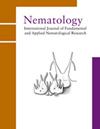Relationship between suppression of plant defence systems by Meloidogyne javanica with the distance of different parts of the plant from the nematode establishment site
IF 1.2
4区 生物学
Q2 ZOOLOGY
引用次数: 0
Abstract
Suppression of plant defence systems by plant-parasitic nematodes is an important aspect of research on resistance induction in plants. The present work aimed to address the question of whether this suppressive ability by nematodes can be spread systemically and equally to other parts of the plant. The root-knot nematode, Meloidogyne javanica, and the host plant, tomato, was used with salicylic acid (SA) as a potent inducer of the plant defence systems. SA was sprayed on the second and fifth leaves, as near and far from the nematode establishment site, respectively. The results of hydrogen peroxide and phenylalanine ammonia lyase enzyme evaluation in the root (site of nematode establishment), crown, second and fifth leaves showed that, firstly, the amount of defence compounds induced by SA in the leaves was not equal in all parts of the plant and gradually decreased from the aerial parts (treatment site) towards the roots. Furthermore, the synthesis and accumulation of the evaluated compounds in the younger parts of the plant (fifth leaf) was more than the older parts (second leaf), and the crown and root. Although the suppression of the plant defence systems by the nematode was transferred to other parts of the plant, the amount of this suppression gradually decreased in the parts farthest from the site of the nematode establishment. Based on the results, it is inferred that the success of a resistance induction strategy in plant disease management depends on the type of pathogen, type of inducer, place of application of the inducer on the plant and the induction area.javanmeloidogyne对植物防御系统的抑制与植物不同部位离线虫建立点的距离的关系
植物寄生线虫对植物防御系统的抑制是植物抗性诱导研究的一个重要方面。目前的工作旨在解决线虫的这种抑制能力是否可以系统地平等地传播到植物的其他部分的问题。将根结线虫(Meloidogyne javanica)和寄主植物番茄与水杨酸(SA)一起使用,作为植物防御系统的有效诱导剂。在离线虫建立点较近和较远的第2叶和第5叶上分别喷洒SA。过氧化氢和苯丙氨酸解氨酶在根(线虫建立部位)、冠、第2叶和第5叶的评价结果表明:首先,SA诱导的防御化合物在植株各部位的数量并不相同,从地上部位(处理部位)向根逐渐减少;此外,所评价的化合物在植株年轻部分(第5叶)的合成和积累量大于老部分(第2叶),以及冠和根。虽然线虫对植物防御系统的抑制作用转移到植物的其他部位,但这种抑制作用在离线虫建立地点最远的部位逐渐减少。结果表明,植物病害管理中抗病诱导策略的成功取决于病原菌类型、诱导剂类型、诱导剂在植物上的施用位置和诱导区域。
本文章由计算机程序翻译,如有差异,请以英文原文为准。
求助全文
约1分钟内获得全文
求助全文
来源期刊

Nematology
生物-动物学
CiteScore
2.60
自引率
33.30%
发文量
67
审稿时长
3 months
期刊介绍:
Nematology is an international journal for the publication of all aspects of nematological research (with the exception of vertebrate parasitology), from molecular biology to field studies. Papers on nematode parasites of arthropods, and on soil free-living nematodes, and on interactions of these and other organisms, are particularly welcome. Research on fresh water and marine nematodes is also considered when the observations are of more general interest.
Nematology publishes full research papers, short communications, Forum articles (which permit an author to express a view on current or fundamental subjects), perspectives on nematology, and reviews of books and other media.
 求助内容:
求助内容: 应助结果提醒方式:
应助结果提醒方式:


